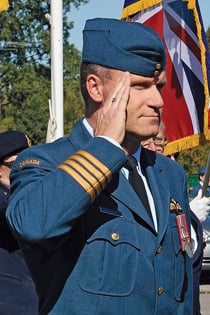There’s no way to spot another Russell Williams
An internal military review concludes there is no off-the-shelf exam to detect sociopathic killers
Share

Kevin West was Russell Williams’s right-hand man at CFB Trenton. If the base commander was at a ribbon cutting ceremony or a photo op with a visiting politician, Chief Warrant Officer West was always nearby. The two men golfed together. They ate dinner, with their wives, at each other’s houses. And on the Sunday night in February 2010 when Williams confessed to police that he was a serial killer in colonel’s clothing, West was among the first in uniform to hear the unthinkable news.
Early the next morning, while Williams was leading police to Jessica Lloyd’s lifeless body, Kevin West picked up his BlackBerry and typed a message to senior staffers at the base. “Ladies and gentlemen,” he wrote, at 2:11 a.m. “Request you all meet in the WHQ conference room as early as possible tomorrow morning. I will be in my office for 0700 hrs. This is extremely important, more information to follow.”
What followed is still difficult to fathom. An elite officer who piloted prime ministers and the Queen—and oversaw the country’s largest air force base—was doubling as a depraved sexual predator who somehow managed to ascend the ranks without a whiff of suspicion. Grasping for an explanation, the Canadian Forces launched an “immediate review” of the way candidates are selected for senior command positions—and whether enhanced psychological testing might have revealed the real Russ Williams.
The answer, sadly, is no. Among hundreds of pages of internal military documents, obtained by Maclean’s under the Access to Information Act, is a draft version of that review. It confirms what leading experts have long maintained: there is no off-the-shelf exam that employers, armed forces or otherwise, can use to detect sociopathic killers. “Given the recent events in CFB Trenton, it is natural for the CF to question whether or not the organization could have identified a sexual sadist or predicted that an individual would become a serial sexual murderer,” the report says. But that “would be unrealistic to expect.”
Every recruit is subject to various levels of screening, including a criminal records check and an aptitude test. Members also undergo an annual evaluation that assesses past performance and potential for promotion. To be considered for senior command (colonels in the army and air force; captains in the navy), an officer’s file must be “thoroughly reviewed” and endorsed by a board of superiors who examine “personal characteristics, demonstrated leadership ability, education and professional development.” Nothing in Williams’s file, an impeccable 23-year career, offered the slightest hint of his alter ego.
Certain high-risk postings (special forces, snipers, military police) do require a formal assessment by a psychologist, who looks for red flags such as emotional instability, anti-social behaviour and past mental health issues. But, as the report states, “this is not a screening for psychopathology.” Although researchers have developed specialized tests that can measure psychopathic traits (a typical psychopath is callous, remorseless, superficial and manipulative), those checklists are designed to dig deeper into the brains of convicted prisoners, not to weed out would-be murderers among the general public.
As the report also points out, not all psychopaths are murderers—and not all murderers are psychopaths. In fact, studies suggest that nearly one per cent of the general population fits the clinical definition of psychopath. But very few are criminals, let alone killers. So even if there was a test that could accurately spot psychopaths, should the military spend the millions of dollars necessary to conduct such testing? “Given the low estimates of psychopathy in the general population, the weak link between psychopathy and criminal behaviour, and the potentially serious career implications of this label, [it] is not recommended for mass screening in the CF,” the report concludes.
Spotting sex offenders is just as difficult as spotting psychopaths—especially if, like Williams, they don’t have a criminal record. Without that criminal record, the most reliable way to detect a sexual sadist is “phallometric” testing: hooking a rubber band to a man’s penis and measuring his reaction to various photographs and videos. “While this test may help to identify atypical arousal patterns, it would never be used without cause, or in isolation, to predict criminal sexual behaviour,” the report states. “The procedure is very intrusive and costly and, for ethical and legal reasons, not recommended for use by CF.”
Now locked in a solitary cell at Kingston Penitentiary, Williams was in the news last week after one of his assault victims filed a lawsuit against him, his wife and the Ontario Provincial Police. A Montreal production company also announced plans to turn the story into a “frightening and insightful” movie.
Until then, the depths of Williams’s heinous double life continue to emerge, bit by bit. At his sentencing hearing, the public learned that he abducted Jessica Lloyd on a Thursday night, then faked a stomach flu so he could skip work while holding her hostage at his Tweed, Ont., cottage. According to the newly released documents, Williams received an email from a subordinate that Friday afternoon—while Lloyd was still alive. “I attended the RCAF Memorial Luncheon today on your behalf,” wrote Lt.-Col. Ross Fetterly. “It was a significant affair and had full attendance.”
At 6:22 p.m., Williams typed a reply on his BlackBerry. “Outstanding,” he wrote. “Thanks very much for having filled in for me . . . I’m sure the last thing you needed was a pop-up two-hour commitment. Take care.”
Two hours later, Jessica Lloyd was dead.